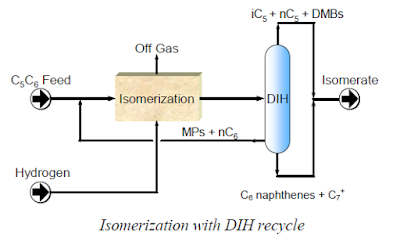HIGH OCTANE C5/C6 CUTS VIA ISOMERIZATION
PROCESSES
MEET
MARKET DEMANDS WITH HIGH OCTANE ISOMERIZATION PROCESSES
From once-through to advanced
recycle isomerization processes, we offer the complete line of isomerization
solutions that, by increasing C5/C6 naphtha cut octane numbers up to 92, go far
to meet tighter gasoline pool specifications. The isomerate product is free of
sulfur, aromatics and olefins, making it an excellent gasoline pool component.
Isomerization fits well with the trend to remove benzene precursors from
reformer feedstock, and possible co-processing of light reformate fractions can
resolve benzene content constraints. The question of which process to select
will depend on a number of criteria such as feed composition and desired octane
number. We have achieved a significant market penetration since the 90’s
through the implementation of innovative process schemes combined with
state-ofthe-art chlorinated alumina catalysts.
CHLORINATED
ALUMINA CATALYSTS
Chlorinated alumina is the
best catalyst to meet the need for today’s high octane requirements. Its high
activity permits operation at the lower reactor temperatures that enable higher
product RON and favor superior yields. The use of molecular sieve adsorbents on
the feed and hydrogen make-up streams ensures the removal of feed contaminants
and long catalyst lifetimes. Chlorinated alumina-based catalysts are also ideal
for retrofitting idle units such as reformers or hydrotreaters with
implementation of feed pretreatment and off-gas neutralization packages. The substantial octane gain and reduced
catalyst cost account for the short pay-back time, usually less than a year.
Our isomerization
technologies employ ATIS-2L catalyst which provides an unsurpassed combination
of high activity low cost and low platinum content.
ONCE-THROUGH
C5/C6 ISOMERIZATION: LOWEST INVESTMENT
COST
This least-cost path to
moderate octane gain can provide, in some cases, a sufficient boost to the
gasoline pool octane. Typically, the octane for a feed having a C5 to C6 ratio
of 40:60 will have an increase in RON from 70 to 83-84 after isomerization. We
employ a permutable reactor design; that is, either reactor can be used in the
lead or lag position or it can be operated independently during catalyst
servicing. This assures ultra-high on-stream service.
OCTANE
ENHANCEMENT WITH DEISOPENTANIZER (DIP) OR DEISOHEXANIZER (DIH)
The maximum octane number
available from a oncethrough system is limited by the thermodynamic equilibrium
of the C5/C6 mixture. Distillation is one way to achieve octane improvement by
either allowing isomers to bypass the reactor (DIP) or by recycling normal
paraffins to the reactor (DIH, shown hereafter). However, these approaches
still leave normal paraffins in the product.
ADVANCED
RECYCLE: IPSORB™
Ipsorb is the most economic
path available to convert all normal paraffins to their iso-paraffins. A vapor
phase mole sieve section is used to adsorb normal paraffins for recycle to the
reactor.
ULTIMATE
OCTANE: HEXORB™
The Hexorb process also
completely adsorbs and converts all normal paraffins to isomers. The difference
is that methyl pentanes (RON 74) are also converted, affording the highest
possible octane for a C5-C6 feed (up to RON 92).
FOR
BETTER BOTTOM LINE RESULTS
Our isomerization technologies
are ready to help meet a refinery's octane objectives, whether it is for a new
unit or debottlenecking and revamping of oncethrough and deisohexanizer units.
Relative differences between the isomerization schemes with regard to
investment cost, operating cost and product revenue, are shown in the table
below. Our isomerization technologies are also well suited for stepwise
installation of octane improvement projects. Typical payout times are on the
order of a year.
COMMERCIAL
EXPERIENCE
We entered the C5-C6
isomerization field late, in the 90’s, with a powerful R&D support at both
lab and pilot scale sizes. Nevertheless, more than 50 isomerization units have
been licensed by Axens, and since the marketing of ATIS-2L catalyst in 2003,
more than 30 new units have been designed.

.png)








